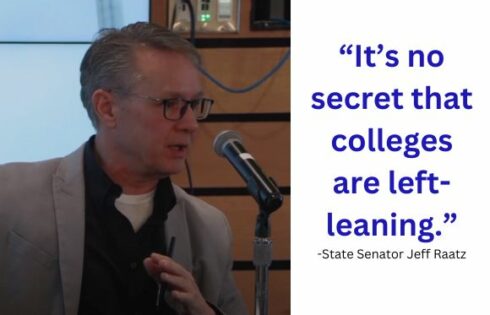 The University of Wisconsin discriminates against whites and Asians in their admissions process. That’s what a study from the Center for Equal Opportunity released last week argues.
The University of Wisconsin discriminates against whites and Asians in their admissions process. That’s what a study from the Center for Equal Opportunity released last week argues.
The reception at the school? Less then congenial. Protests shut down a press conference for Roger Clegg, the president of the group, to discuss the study.
The study found the median composite SAT score for black undergraduates admitted to the university was 150 points lower than for white and Asian students, and for Latino undergraduates 100 points lower. The report also concluded that, in the admissions process, black students were favored 576-to-1 over white and Asian students, and Latinos were favored 504-to-1. The ratios were calculated through a comparison of SAT scores and class rank.
The data was collected after a lengthy legal battle between the center and the school that made its way up to the Wisconsin Supreme Court where the court ruled in favor of the center’s request for the admissions data.
Nico Perrino: Are schools generally reluctant to turn over admissions data, or was UW-Madison was more so?
Roger Clegg: UW was certainly toward the less-cooperative end of the spectrum. It’s hard for me to say for sure why this was so. To some degree, UW officials might have believed the legal arguments they made (unsuccessfully, as it turned out). But it’s also likely they were in no mood to do us any favors, since they knew we disagreed with them on the underlying policy of racial preferences. And, yes, maybe they knew they had something to hide.
Perrino: How does the information you found within the UW-Madison admissions data compare to other schools’ data?
Clegg: The odds ratios were the highest (that is, the worst) for undergrad admissions of any we’ve ever seen.
Perrino: Has UW-Madison responded to the report substantively?
Clegg: Putting aside the protests, etc. that it helped instigate, it has responded as most other universities have responded in the past: It doesn’t deny that it uses racial and ethnic preferences, but it points to “soft” factors that our study didn’t consider, such as teacher recommendations and the like. Our reply is that such factors would not have been turned over to us if we had asked for them (because of privacy concerns), and they are not really suitable for a study such as ours anyhow (since it is hard to rank the favorability of different teacher recommendations and the like).
But our fundamental point is that it is extremely unlikely that considering such soft factors would have changed the conclusions of the studies, since there is no reason to think that the teacher recommendations, etc. for blacks and Latinos would be so much more favorable than those for whites and Asians that they would explain away the other, overwhelming evidence of bias in the other direction that we found. To the contrary, one would expect students with better grades and test scores to get better teacher recommendations, etc.
Perrino: Do you think UW-Madison will change its admissions standards at some point because of the report?
Clegg: Yes, eventually — either directly or indirectly.
Perrino: What does the future look like for affirmative action policies at American colleges and universities?
Clegg: The use of racial and ethnic preferences will end, sooner or later. They cannot be justified, they are legally vulnerable, and most Americans dislike them. They become harder and harder to justify with every tick of the clock, as the Jim Crow era becomes more and more distant, and as America becomes increasing a multiethnic and multiracial society.
The fact is that it is simply untenable for our government institutions, including public universities, to have policies in 2011 that discriminate on the basis of skin color and what country someone’s ancestors came from.
To see why, just take a look at the “National Population” census chart.
It shows that America is more and more a multiracial and multiethnic country. Over one in four Americans now say they are something other than simply “white.” Blacks are no longer the largest minority group: Latinos are.
And blacks and whites are the slowest growing populations. Since the last census, the Latino population has grown by 43.0 percent, and the Asian population has grown even faster: by 43.3 percent. The black population has grown by only 12.3 percent, and the white population by only 5.7 percent.
And it’s interesting that the number of Americans who identify themselves as belonging to “two or more races” has grown by 32.0 percent. That doesn’t even count those Americans, like our president, who are multiracial but for whatever reason declined to identify themselves in that way on the census form.
In such a country, as I said, it is simply untenable for the government to classify and sort people on the basis of skin color and national origin, and to treat its citizens differently—some better, some worse—depending on which silly little box is checked.
In a country like ours, the only system that will work is one where the government plays no favorites. Anything else is a recipe for disaster—for division, strife, and balkanization.
Nico Perrino is a columnist for the Indiana Daily Student. He is a contributor to The College Fix.
Like The College Fix on Facebook / Follow us on Twitter




Please join the conversation about our stories on Facebook, Twitter, Instagram, Reddit, MeWe, Rumble, Gab, Minds and Gettr.